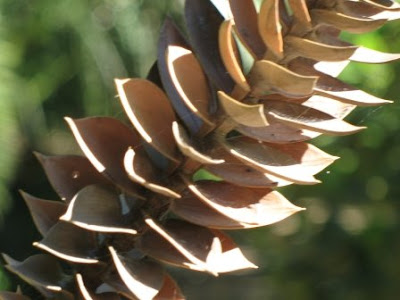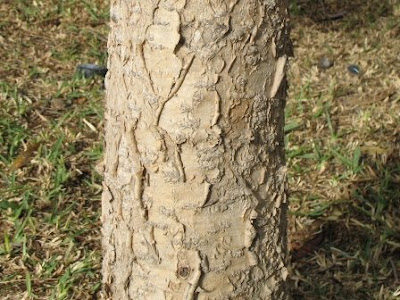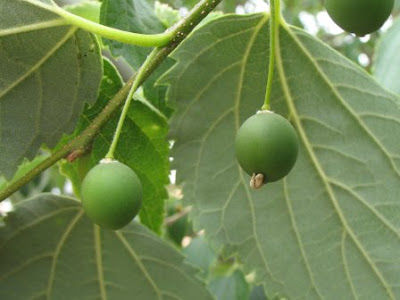
The Bunya Pine (Araucaria bidwillii) is a tree species native to Queensland, Australia and a member of the Araucaria genus. Some of its close relatives in this genus are the
Monkey Puzzle tree, the
Norfolk Island pine and the
Cook pine. The Bunya pine is considered a "living fossil" as it is a tree species that is found in the fossil record in South America and Europe dating to the Jurassic period.

The first picture of this post shows the light green juvenile leaves shortly after they have formed in the spring on a young tree. The image above is of the mature adult leaves that form on older trees. This one is from a whorled leaf stem that I found on the ground under a large tree. The leaflets on these mature trees are shorter, wider and stiffer than their juvenile counterparts.

The seed cones of the Bunya pine closely resemble pineapples and in fact can grow to be
larger than pineapples! The seeds that these cones produce are edible and have been used as a food source by aboriginal peoples. In the picture below you can see the pollen cones of the Bunya pine which are about 1.5 cm wide and 10-15 cm long. If you find one of these on the ground and shake it a large quantity of yellow pollen will fall out.

The image below shows how the leaflets grow on the stem year around but vary in length depending on which season they grew in. Araucaria "pines" have a rather unique leaf system. The "branches" seen below are more like leaf stems than branches. The individual leaflets grow on the full length of the stem in a whorled pattern with approximately 150 leaflets on each. After about three years (my estimate) the stems turn brown and fall off the tree. They are about 3 feet (85cm) long at full length. For this reason the ground under these trees is usually covered with these dry leaf stems which are VERY sharp and prickly. Some of the stems don´t snap off but rather become to continuation of the main branch to which the rest of the stems are connected.

While this tree is native to Australia these pictures where taken in the South of Spain where they were planted in botanical gardens over a hundred years ago. The tall Bunya pine below is located in near the center of Malaga in what the locals call the "paseo del parque". I estimate the height of this tree to be about 40 meters (120-130 feet).

The bark of the mature Bunya pines trees reminds me of chocolate with crunchy nuts. It is light brown, somewhat glossy and has a bumpy texture.

Below is an image of the juvenile bark on a young tree.

For more interesting Australian trees check out these...
Australian silver-oakBush KurrajongCoral GumIllawara Flame tree
 The European Hackberry (Celtis australis) is a tree species that also goes by the names European Nettle tree and Lote tree and is possibly the tree that the "Lotus-eaters" ate from as referenced by Homer.
The European Hackberry (Celtis australis) is a tree species that also goes by the names European Nettle tree and Lote tree and is possibly the tree that the "Lotus-eaters" ate from as referenced by Homer. The fruit of the European hHackberry is a small berry like "drupe" that hangs on the end of a short stem connected to the base of the leaf stem. The size of the fruit is about one half inch in diameter.
The fruit of the European hHackberry is a small berry like "drupe" that hangs on the end of a short stem connected to the base of the leaf stem. The size of the fruit is about one half inch in diameter. Below is another view of the large tree (image above) from a different angle.
Below is another view of the large tree (image above) from a different angle. The leaf of the Celtis australis is simple in shape with serrate margins and measures about 2-3 inches long. The top side is a darker green than the bottom side which is also "fuzzier" also.
The leaf of the Celtis australis is simple in shape with serrate margins and measures about 2-3 inches long. The top side is a darker green than the bottom side which is also "fuzzier" also. The bark is light gray and with age develops interesting shapes. One of the shapes in the picture below looks a bit like an eye.
The bark is light gray and with age develops interesting shapes. One of the shapes in the picture below looks a bit like an eye. I found another large example of the European Hackberry tree on the grounds of the Cathedral of Málaga. From the size of its trunk it looks like it has been growing there for a rather long time.
I found another large example of the European Hackberry tree on the grounds of the Cathedral of Málaga. From the size of its trunk it looks like it has been growing there for a rather long time.













































